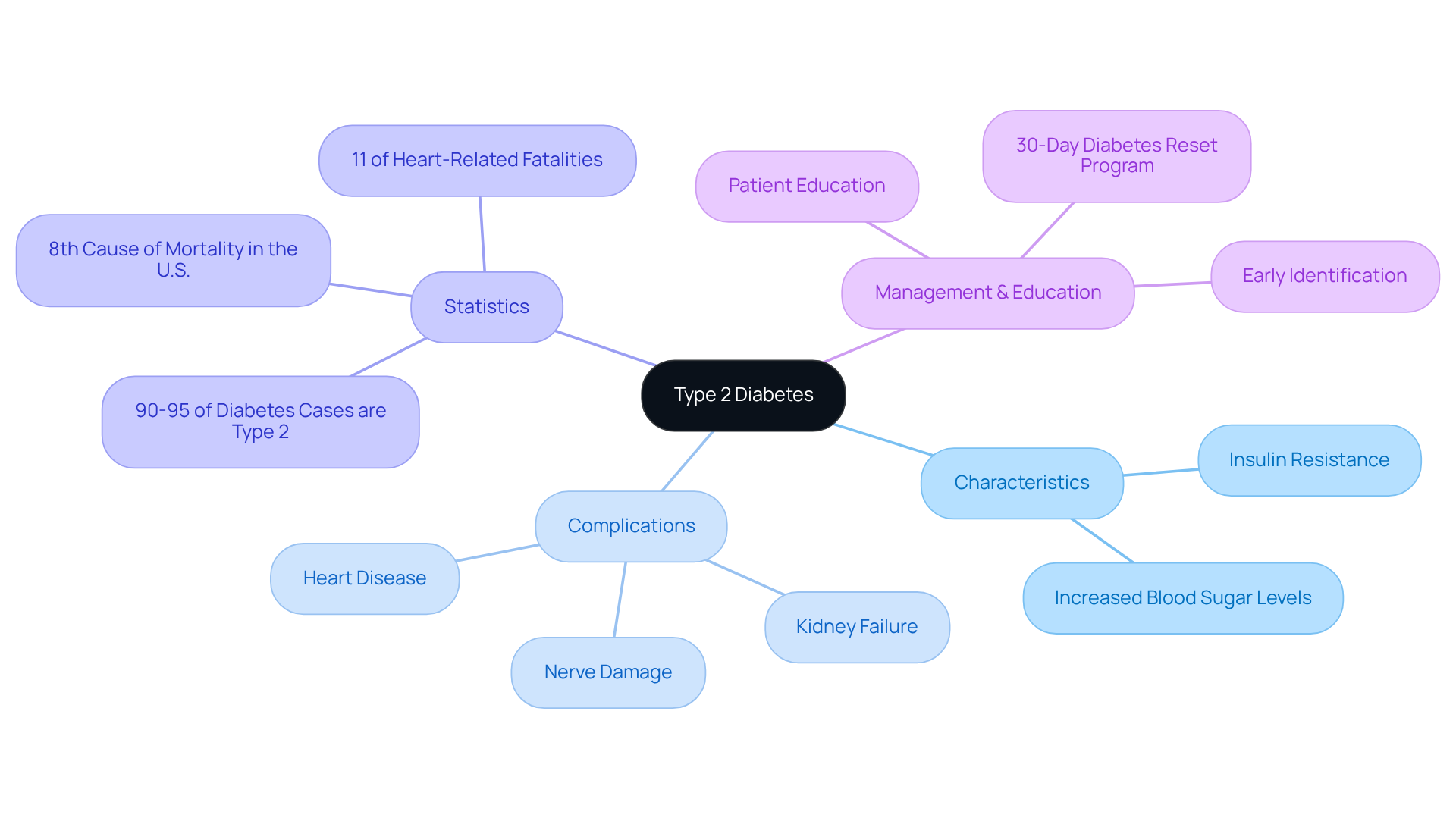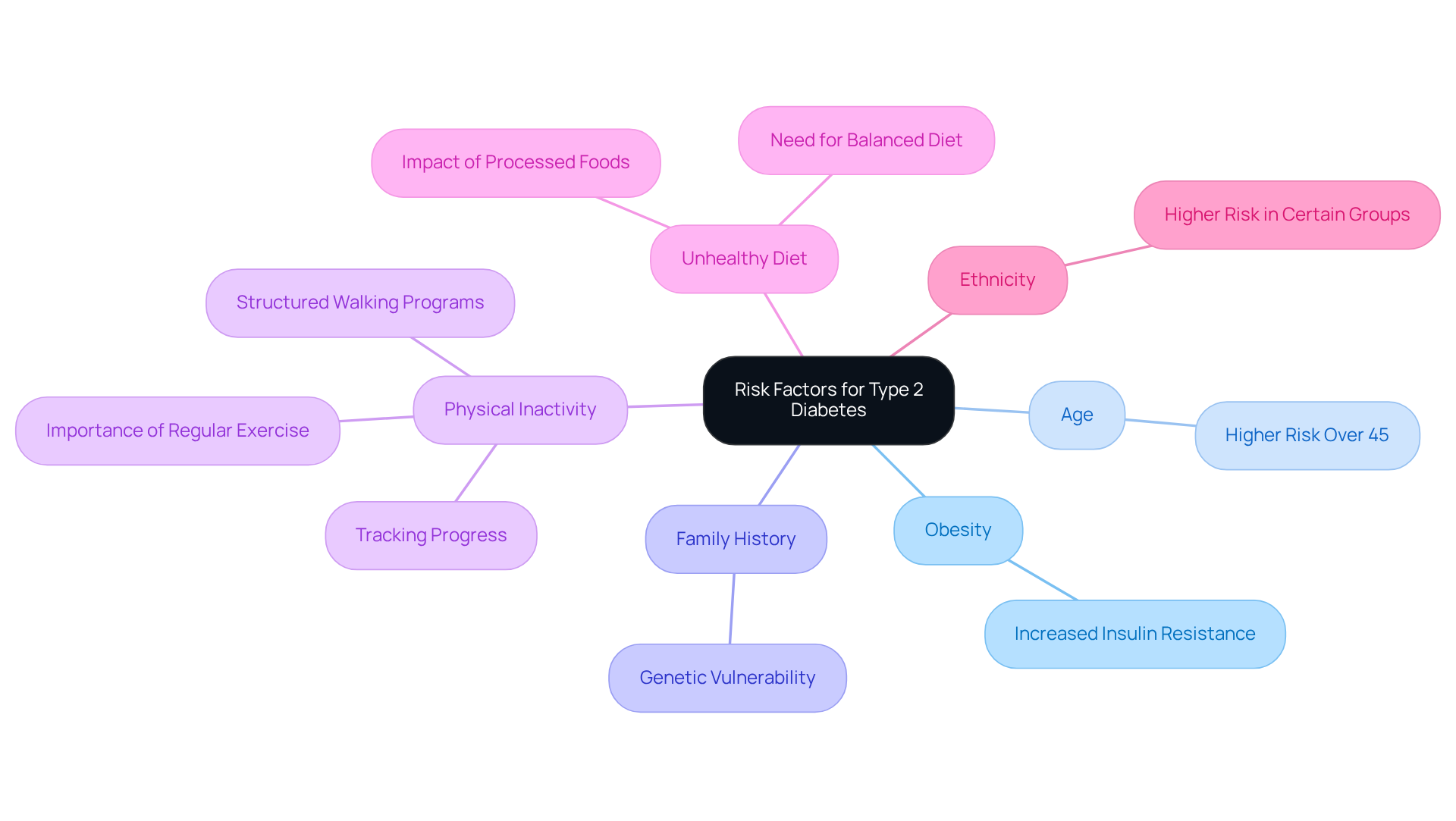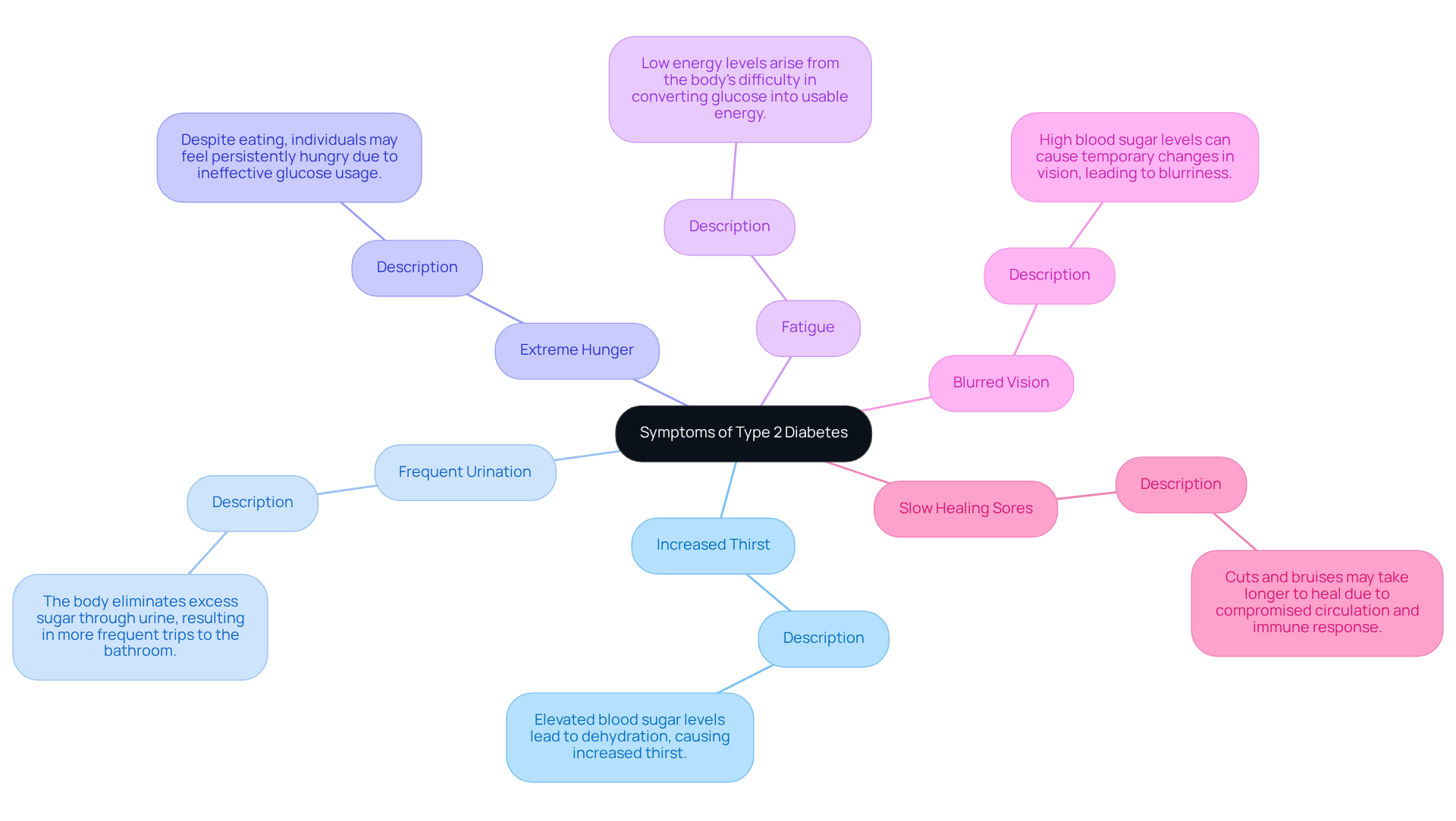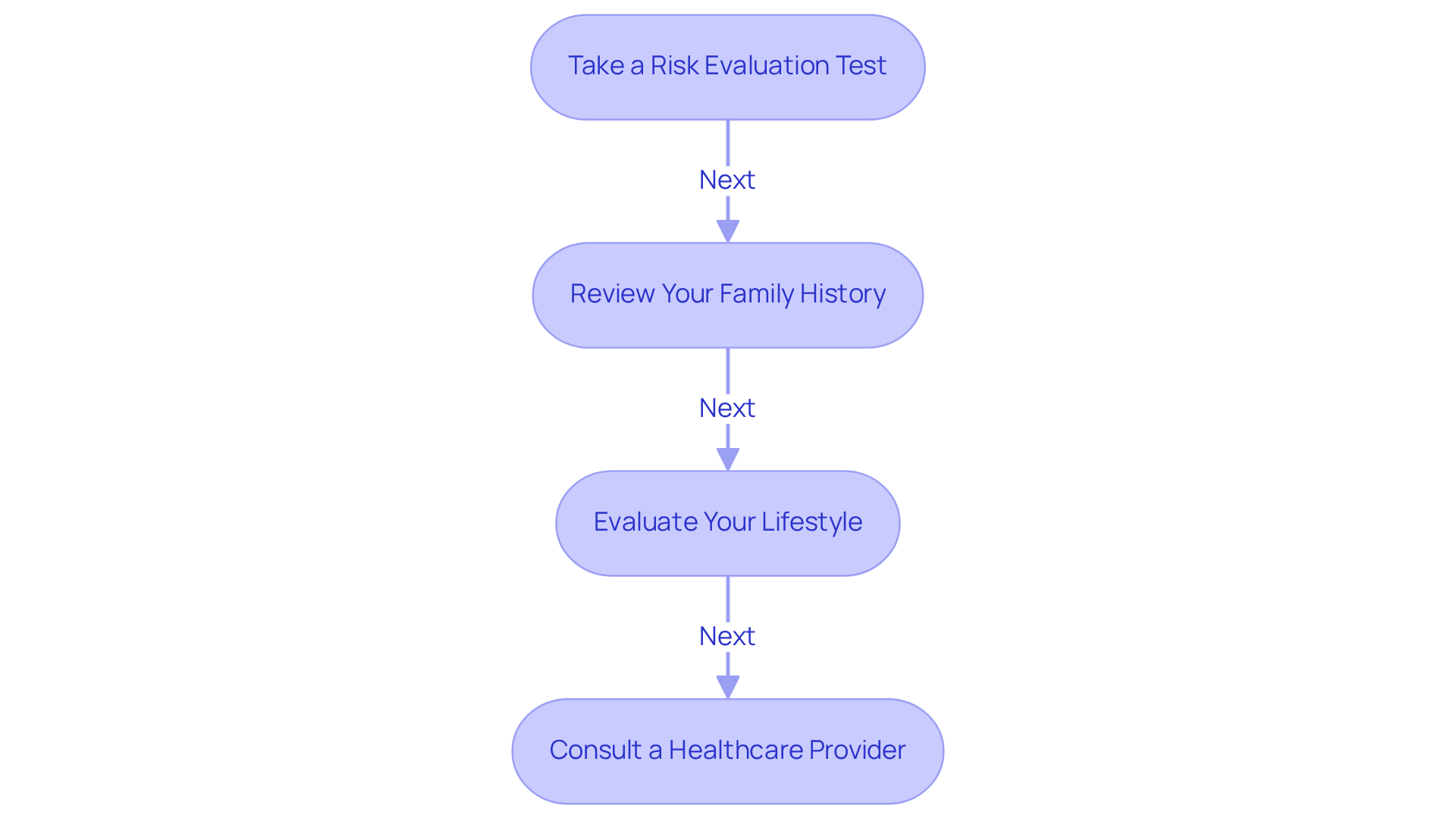Overview
Type 2 diabetes primarily affects individuals who may be feeling overwhelmed by their circumstances—those who are:
- Obese
- Older
- Physically inactive
- Have a family history of diabetes
- Follow an unhealthy diet
- Belong to certain ethnic groups
It’s important to recognize that acknowledging these risk factors and symptoms can be a crucial first step toward early intervention and management. By doing so, you can significantly reduce the risk of severe complications associated with this condition.
Many patients find that understanding their situation can be empowering. Taking action, whether it’s through lifestyle changes or seeking support, can lead to a healthier, more fulfilling life. We invite you to explore the 30-Day Diabetes Reset program, where you can find guidance tailored to your needs. Remember, you are not alone on this journey—there are resources and communities ready to support you.
Introduction
Understanding the complexities of Type 2 diabetes is essential, as this chronic condition quietly impacts millions, often without their awareness. It’s important to recognize that by exploring the risk factors and symptoms associated with this disease, individuals can gain valuable insights into their health. This knowledge empowers them to take proactive steps toward prevention and management.
However, many patients find that the challenge lies in recognizing these often subtle signs and understanding who is truly at risk. What can be done to help individuals identify their vulnerabilities and take control of their health journey? Together, we can navigate this path toward better health.
Define Type 2 Diabetes and Its Impact
Type 2 diabetes is a long-lasting condition that can feel overwhelming. It’s characterized by insulin resistance, meaning the body struggles to use insulin effectively, which leads to increased blood sugar levels. This condition can result in serious medical complications, such as heart disease, kidney failure, and nerve damage, all of which can significantly affect your overall well-being and quality of life.
It’s important to recognize that unmanaged Type 2 diabetes can lead to severe complications. In fact, it ranked as the eighth primary cause of mortality in the U.S. in 2021, with over 103,000 death certificates citing it as the root cause. Many patients find that living with blood sugar conditions increases the likelihood of developing further health issues, including cardiovascular diseases, which account for about 11% of heart-related fatalities worldwide.
The gradual emergence of this condition often means that signs may go unnoticed for years. This highlights the essential need for early identification and proactive management to prevent long-term wellness implications. Health experts stress that without appropriate management, the burden of diabetes can diminish your quality of life. Education and awareness are vital for those at risk.
Have you ever felt uncertain about your health? It’s completely normal to have concerns, but remember, you are not alone. Taking steps toward understanding and managing your condition can lead to a healthier, more fulfilling life. Consider exploring programs like the 30-Day Diabetes Reset to empower yourself and take control of your health journey.
Identify Risk Factors for Type 2 Diabetes
Understanding the factors that contribute to who gets type 2 diabetes is crucial for your health management journey. It’s important to recognize that multiple elements can lead to this condition, and identifying who gets type 2 diabetes can empower you to take proactive steps. Here are some key factors to consider:
- Obesity: Carrying excess weight, especially around your abdomen, can increase insulin resistance.
- Age: If you’re over 45, you may find yourself at a higher risk.
- Family History: A family background of those who get type 2 diabetes can elevate your vulnerability.
- Physical Inactivity: Engaging in regular exercise is vital. Many patients find that starting a structured walking program and setting SMART goals can significantly enhance their activity levels. Tracking your progress with fitness apps or journals can provide additional support.
- Unhealthy Diet: Diets rich in processed foods and sugars can lead to obesity and diabetes. Embracing a balanced diet is essential for your overall well-being.
- Ethnicity: Certain ethnic groups, including African Americans, Hispanic Americans, and Native Americans, may face greater risks regarding who gets type 2 diabetes.
By recognizing these risk factors, you can evaluate who gets type 2 diabetes and adopt effective strategies. Consider monitoring your progress and establishing attainable wellness objectives as steps toward prevention. If you’re seeking personalized support, reaching out to the Integrative Wellness Center can be a great way to explore functional medicine approaches tailored to your unique health needs. Remember, you’re not alone on this journey; support is available to help you thrive.
Recognize Symptoms of Type 2 Diabetes
Common symptoms of type 2 diabetes who gets type 2 diabetes can be concerning, and recognizing them is a crucial step in your health journey. These symptoms include:
- Increased Thirst: You may find yourself reaching for water more often, as elevated blood sugar levels can lead to dehydration.
- Frequent Urination: Your body might be working hard to eliminate excess sugar through urine, resulting in more frequent trips to the bathroom.
- Extreme Hunger: Despite eating, you may still feel persistently hungry, as your body struggles to use glucose effectively.
- Fatigue: Low energy levels can be a challenge, stemming from your body’s difficulty in converting glucose into usable energy.
- Blurred Vision: You might experience temporary changes in vision, with high blood sugar levels causing blurriness.
- Slow Healing Sores: Cuts and bruises may take longer to heal, which can be unsettling, as compromised circulation and immune response play a role.
Identifying these symptoms is essential for individuals who get type 2 diabetes, as early intervention can significantly reduce the risk of complications. Many patients who get type 2 diabetes find that seeking medical advice promptly upon noticing these signs leads to better management of their condition and a lower incidence of severe complications. Dr. Jason Shumard emphasizes, “Awareness of these symptoms can lead to timely diagnosis and treatment, ultimately improving quality of life for those affected.”
It’s important to recognize that incorporating tracking methods, such as fitness apps, can empower you in your health journey. Setting SMART goals can also be beneficial. Real-world examples show that individuals who identified their symptoms early were able to make lifestyle modifications that not only controlled their condition but also placed it into remission. Remember, you are not alone in this journey, and taking these steps can lead to a healthier, happier life.
Assess Your Risk for Type 2 Diabetes
To effectively assess your risk for type 2 diabetes, consider these essential steps:
-
Take a Risk Evaluation Test: Have you thought about using online tools, like the American Diabetes Association’s assessment test? These evaluations can provide a quick overview of your potential risk factors, helping you understand your situation better.
-
Review Your Family History: It’s important to reflect on your family history. Did you know that approximately 12.1% of non-Hispanic Black adults and 11.7% of Hispanic adults are diagnosed with this condition? This highlights a significant genetic component. Understanding your family’s health background can help you identify possible risks.
-
Evaluate Your Lifestyle: Take a moment to think about your diet, physical activity levels, and weight. Research shows that making integrated lifestyle changes can reduce the likelihood of developing type 2 diabetes by around 50%. Have you considered increasing your physical activity to meet the recommended goal of at least 150 minutes per week? Setting SMART goals—specific, measurable, attainable, relevant, and time-bound—can significantly enhance your focus and motivation. For instance, why not aim to walk an additional 1,000 steps each week? Tracking your progress with fitness apps, journals, or pedometers can also be very helpful.
-
Consult a Healthcare Provider: If you notice several contributing factors, it might be time to arrange an appointment with your healthcare provider for further assessment and possible testing. Engaging with a healthcare professional can provide personalized insights and recommendations tailored to your specific situation. It’s essential to understand the consequences of increased insulin levels, as they can be associated with various medical problems, including weight gain and heart conditions, which are significant contributors to adult-onset illnesses.
By taking these proactive steps, you can gain a clearer understanding of who gets type 2 diabetes and make informed decisions about your health. For further assistance and resources, consider reaching out to the Integrative Wellness Center. Remember, you’re not alone on this journey; support is available to help you thrive.
Conclusion
Understanding Type 2 diabetes is crucial for anyone looking to safeguard their health. This condition, marked by insulin resistance and elevated blood sugar levels, can lead to serious complications if left unmanaged. With its status as a leading cause of mortality and the potential for debilitating health issues, recognizing the importance of early intervention and proactive management becomes paramount.
It’s important to recognize that there are key risk factors contributing to the development of Type 2 diabetes. These include obesity, age, family history, physical inactivity, and dietary choices. Many patients find that being aware of common symptoms—such as increased thirst, fatigue, and blurred vision—can serve as critical indicators for timely diagnosis and treatment. Furthermore, practical steps for assessing personal risk, such as utilizing risk evaluation tests and consulting healthcare providers, empower individuals to take charge of their health.
Ultimately, the journey to understanding and managing Type 2 diabetes is one of empowerment and knowledge. By recognizing risk factors, being vigilant about symptoms, and taking proactive steps towards lifestyle changes, individuals can significantly reduce their risk and improve their overall quality of life. It is essential to seek support and resources, as the path to better health is not one that needs to be traveled alone.
Key Tips for Managing Your Health:
- Stay informed about your risk factors.
- Monitor your symptoms closely.
- Consult with healthcare providers regularly.
- Make gradual lifestyle changes that promote well-being.
Remember, you’re not alone on this journey. Connecting with others who share similar experiences can provide invaluable support and encouragement.
Frequently Asked Questions
What is Type 2 diabetes?
Type 2 diabetes is a long-lasting condition characterized by insulin resistance, where the body struggles to use insulin effectively, leading to increased blood sugar levels.
What are the potential health complications associated with Type 2 diabetes?
Type 2 diabetes can result in serious medical complications such as heart disease, kidney failure, and nerve damage, significantly affecting overall well-being and quality of life.
How does Type 2 diabetes rank as a cause of mortality in the U.S.?
In 2021, Type 2 diabetes was the eighth primary cause of mortality in the U.S., with over 103,000 death certificates citing it as the root cause.
What additional health risks are associated with unmanaged Type 2 diabetes?
Unmanaged Type 2 diabetes increases the likelihood of developing further health issues, including cardiovascular diseases, which account for about 11% of heart-related fatalities worldwide.
Why is early identification and management of Type 2 diabetes important?
The gradual emergence of Type 2 diabetes often means that signs may go unnoticed for years, making early identification and proactive management essential to prevent long-term wellness implications.
What role does education and awareness play for those at risk of Type 2 diabetes?
Education and awareness are vital for those at risk, as they help individuals understand and manage their condition, potentially leading to improved health outcomes.
What resources are available for individuals looking to manage their Type 2 diabetes?
Programs like the 30-Day Diabetes Reset can empower individuals to take control of their health journey and manage their condition effectively.



